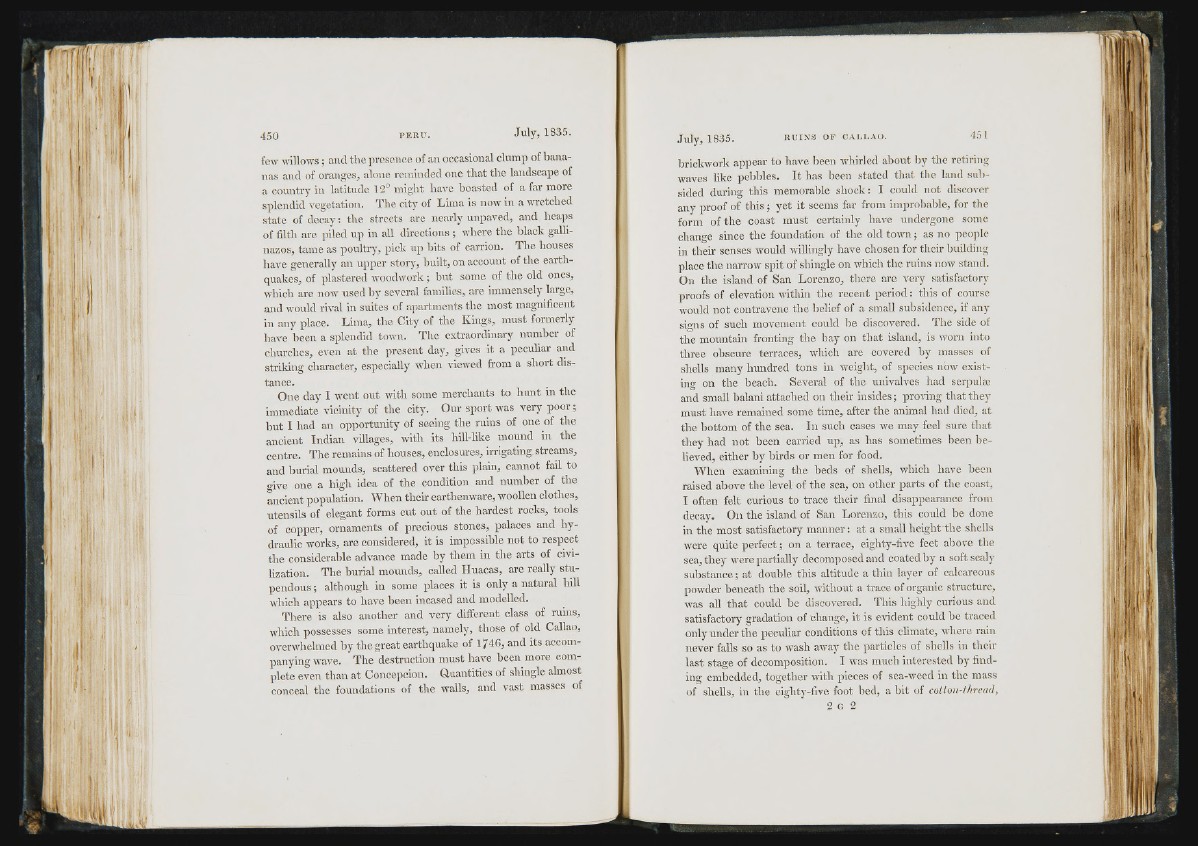
I
ft .7
ri' I '
, ! L , ; i
few willows ; and the presence of an occasional clump of bananas
and of oranges, alone reminded one that the landscape of
a country in latitude 12° might have boasted of a far more
splendid vegetation. The city of Lima is now in a wretched
state of decay; the streets are nearly unpaved, and heaps
of filth are piled up in all directions ; where the black gallinazos,
tame as poultry, pick up bits of carrion. The houses
have generally an upper story, built, on account of the earthquakes,
of plastered woodwork; hut some of the old ones,
which are now used by several families, are immensely large,
and would rival in suites of apartments the most magnificent
in any place. Lima, the City of the Kings, must formerly
have been a splendid town. The extraordinary number of
churches, even at the present day, gives it a peculiar and
striking character, especially when viewed from a short dis-
tance.
One day I went out with some merchants to hunt in the
immediate vicinity of the city. Our sport was veiy poor;
hut I had an opportunity of seeing the ruins of one of the
ancient Indian villages, with its hill-like mound in the
centre. The remains of houses, enclosures, irrigating,streams,
and burial mounds, scattered over this plain, cannot fail to
give one a high idea of the condition and number of the
ancient population. When their earthenware, woollen clothes,
utensils of elegant forms cut out of the hardest rocks, tools
of copper, ornaments of precious stones, palaces and hydraulic
works, are considered, it is impossible not to respect
the considerable advance made hy them in the arts of civilization.
The burial mounds, called Huacas, are really stupendous
; although in some places it is only a natural hill
which appears to have been incased and modelled.
There is also another and very different class of rums,
which possesses some interest, namely, those of old Callao,
overwhelmed by the great earthquake of 1746, and its accompanying
wave. The destruction must have been more complete
even than at Concepcion. Quantities of shingle almost
conceal the foundations of the walls, and vast masses of
7i i
brickwork appear to have been whirled about liy the retiring
waves like pebbles. It has been stated that tlie land subsided
during this memorable shock; I could not discover
any proof of th is; yet it seems far from improbable, for the
form of the coast must certainly have undergone some
change since the foundation of the old town; as no people
in their senses would willingly have chosen for their building
place the narrow spit of shingle on which the ruins now stand.
On the island of San Lorenzo, there are very satisfactory
proofs of elevation within the recent period: this of course
would not contravene the belief of a small subsidence, if any
signs of such movement could be discovered. The side of
the mountain fronting the bay on that island, is worn into
three obscure terraces, which are covered by masses of
shells many hundred tons in weight, of species now existing
on the beach. Several of the univalves had serpulm
and small balani attached on their insides; proving that they
must have remained some time, after the animal had died, at
the bottom of the sea. In such cases we may feel sure that
they had not been carried up, as has sometimes been believed,
either by birds or men for food.
When examining the beds of shells, which have been
raised above the level of the sea, on other parts of the coast,
I often felt curious to trace their final disappearance from
decay. On the island of San Lorenzo, this could be done
in the most satisfactory manner: at a small height the shells
were quite perfect; on a terrace, eighty-five feet above the
sea, they were partially decomposed and coated hy a soft scaly
substance; at double this altitude a thin layer of calcareous
powder beneath the soil, without a trace of organic structure,
was all that could be discovered. This highly curious and
satisfactory gradation of change, it is eifident could be traced
only under the peculiar conditions of this climate, where rain
never falls so as to wash away the particles of shells in their
last stage of decomposition. I was much interested by finding
embedded, together with pieces of sea-weed in the mass
of shells, in the eighty-five foot bed, a bit of colion-threud,
2 G 2
IR'!